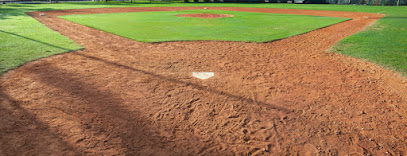First base
First base is the first of the four bases that must be touched by a runner in order to score a run for the batting team. The runner may continue running past first base in a straight line without being in jeopardy of being put out, so long as they make contact with first base and make no move or attempt to advance to second base.
The first baseman is the defensive player mainly responsible for the area near first base. A first baseman is often tall.[citation needed] A tall first baseman has a larger range for reaching and catching errant throws.
In some youth leagues and adult recreational leagues, a "double first base" or "safety first base" is used. A double first base is rectangular (rather than square), measuring 30 by 15 inches. It is normally colored white and orange (two 15 by 15 inches squares). It is placed with the white half in fair territory and the orange half in foul territory. The white half is used by the first baseman to make plays while the orange half is used by the runner. This creates a separation between the first baseman and runner, reducing the chance of injury on plays at first base.
In the numbering system used to record defensive plays, the first baseman is assigned the number 3.
Second base
Second base is the second of the four bases a runner must touch in order to score a run. Second base is mainly defended by the second baseman and the shortstop. The second baseman and shortstop ideally possess quick feet and the ability to release the ball rapidly and accurately. One player will usually cover second base while the other attempts to field the ball. Both players must communicate well to be able to make a double play. Particular agility is required of the second baseman in double play situations, which usually force the player to throw towards first base while their momentum carries them in the opposite direction.
A runner on second base is said to be in "scoring position", since there is a higher likelihood of scoring a run from second base on a single. Since second base is the farthest from home plate, it is the most commonly stolen base in baseball.
In the numbering system used to record defensive plays, the second baseman is assigned the number 4, and the shortstop 6.
Third base
Third base is the third of the four bases a runner must touch in order to score a run. The third baseman is the defensive player mainly responsible for the area nearest third base. A third baseman ideally possesses quick reaction to batted balls and a strong arm to make the long throw to first base. In the numbering system used to record defensive plays, the third baseman is assigned the number 5.
Like a runner on second base, a runner on third base is said to be in "scoring position", since there is a higher likelihood of scoring a run on a single or sacrifice fly provided that the third and final out is not recorded before they can reach home plate.
Home base
Home base, usually called "home plate", is the final base that a player must touch to score a run. Unlike the other bases, home plate is a five-sided slab of white rubber that is set at ground level.


No comments:
Post a Comment